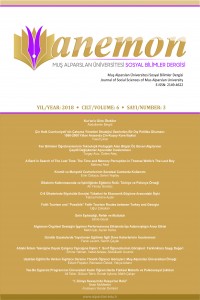Abstract
Thomas Wolfe is an American writer who uses
autobiographical elements artfully in his works. Wolfe writes about the
self-searching of Eugene Gant, the main character in The Lost Boy, who characterizes himself, Thomas Wolfe. The book
consists of four parts. Each part contains a different family member's
narration about past and memories. During self- searching Eugene Gant benefits
from family photos, living spaces and even the slightest crumbs that animate
memories. He tries to bring to light the memories, which were pushed into
subconscious, benefiting from narratives of family members. Time is a factor
which pushes the memories into subconscious, makes them forget in this story
where elements such as loss, loneliness, time flies, shape the leitmotif. Time
is also a factor bringing memories alive through different elements. In this
study Eugene Gant's reanimating of the memories by linking past to present will
be examined.
Keywords
References
- Albrecht, W.P. (1953). Time as Unity in Thomas Wolfe. In: The Enigma of Thomas Wolfe (pp. 239-248). USA: Harvard University Press.
- Bergson, H. (2016). Time and Free Will. New York: Dover Publications.
- Childs, P. (2002). Modernism. London and New York: Taylor and Francis e-Library.
- Conway, M.A. (2006,). Memory and desire: Reading Freud. The Psychologist, 19(9), 548-550.
- DeVoto, B. (1953). Genius is not Enough. In: Walser, R. (Ed.), The enigma of Thomas Wolfe (pp. 140-148). USA: Harvard University Press.
- Edel, L. (1959). The Modern Psychological Novel. USA: Grove Press.
- Freud, S. (2013). Yaşamım ve Psikanalizm. K. Şipal (Trans.). İstanbul: Say Yayınları.
- Kalay, F. (2016). Şu Philip Roth Ne İster. Konya: Çizgi Kitapevi.
- Kennedy, R. S. (1962). The Window of Memory: The Literary Career of Thomas Wolfe. USA: The University of North Carolina Press.
- Nowell, E. (Ed.). (1956). The Letters of Thomas Wolfe. New York: Charles Scribner’s Sons.
- Sullivan, E. (2002). Recovering the Past: Models of Time in Thomas Wolfe’s The Lost Boy. In: Zahlan,A. R. (Ed.), The Thomas Wolfe review (pp. 68-75). USA: Thomas Wolfe Society.
- Wolfe, T. (1929). Look Homeward Angel. New York: Charles Scribner’s Sons.
- Wolfe, T. (1943). The Lost Boy. In: The Hills Beyond (pp.1-42). USA: The Sun Dial Press.
- Wolfe, T. (1947). The Web and The Rock. London: William Heinemann.
- Wolfe, T. (1953). Something of My Life. In: The Enigma of Thomas Wolfe (pp. 3-7). USA: Harvard University Press.
- Wolfe, T. (1964). You Can’t Go Home Again. New York: Dell Publishing.
Abstract
Thomas
Wolfe eserlerinde otobiyografik öğeleri ustaca kullanan Amerikalı bir yazardır.
Thomas Wolfe, “The Lost Boy” adlı kısa hikâyesinde kendisini de karakterize
eden Eugene Gant’in öz arayışını incelemektir. Eser dört bölümünden
oluşmaktadır. Her bölüm farklı bir aile bireyinin geçmiş zaman ve anılarına
dair anlatımını içermektedir. Eugene Gant, öz arayışı esnasında; anılarını
canlandıran aile fotoğraflarından, yaşanan mekânlardan ve hatta en ufak anı
kırıntılarından bile yararlanır. Aile bireylerinin anlatımlarından yararlanarak
bilinçaltına itilen anıları gün yüzüne çıkarmaya çalışır. Ana temasını
yitiklik, yalnızlık, zamanın akıp gitmesi gibi unsurların şekillendirdiği bu
hikâyede zaman; anıları bilinçaltına iten, unutturan ve silip yok eden bir
unsurdur. Zaman, aynı zamanda, farklı etmenler aracılığı ile anıların
canlanmasını sağlayan bir unsurdur. Bu çalışmada, Eugene Gant’in geçmiş zaman
ve şimdiyi bir birine bağlayarak anıları tekrardan canlandırması
incelenecektir.
References
- Albrecht, W.P. (1953). Time as Unity in Thomas Wolfe. In: The Enigma of Thomas Wolfe (pp. 239-248). USA: Harvard University Press.
- Bergson, H. (2016). Time and Free Will. New York: Dover Publications.
- Childs, P. (2002). Modernism. London and New York: Taylor and Francis e-Library.
- Conway, M.A. (2006,). Memory and desire: Reading Freud. The Psychologist, 19(9), 548-550.
- DeVoto, B. (1953). Genius is not Enough. In: Walser, R. (Ed.), The enigma of Thomas Wolfe (pp. 140-148). USA: Harvard University Press.
- Edel, L. (1959). The Modern Psychological Novel. USA: Grove Press.
- Freud, S. (2013). Yaşamım ve Psikanalizm. K. Şipal (Trans.). İstanbul: Say Yayınları.
- Kalay, F. (2016). Şu Philip Roth Ne İster. Konya: Çizgi Kitapevi.
- Kennedy, R. S. (1962). The Window of Memory: The Literary Career of Thomas Wolfe. USA: The University of North Carolina Press.
- Nowell, E. (Ed.). (1956). The Letters of Thomas Wolfe. New York: Charles Scribner’s Sons.
- Sullivan, E. (2002). Recovering the Past: Models of Time in Thomas Wolfe’s The Lost Boy. In: Zahlan,A. R. (Ed.), The Thomas Wolfe review (pp. 68-75). USA: Thomas Wolfe Society.
- Wolfe, T. (1929). Look Homeward Angel. New York: Charles Scribner’s Sons.
- Wolfe, T. (1943). The Lost Boy. In: The Hills Beyond (pp.1-42). USA: The Sun Dial Press.
- Wolfe, T. (1947). The Web and The Rock. London: William Heinemann.
- Wolfe, T. (1953). Something of My Life. In: The Enigma of Thomas Wolfe (pp. 3-7). USA: Harvard University Press.
- Wolfe, T. (1964). You Can’t Go Home Again. New York: Dell Publishing.
Details
| Primary Language | English |
|---|---|
| Journal Section | Research Article |
| Authors | |
| Publication Date | April 11, 2018 |
| Acceptance Date | February 1, 2018 |
| Published in Issue | Year 2018 Volume: 6 Issue: 3 |
Cited By
Yitik Kuşak ve Sürgündeki Sanatçı: Thomas Wolfe’un anlatılarında yitiklik ve sürgün kavramlarına bir bakış ve sanatçının ruhsal arayışı
RumeliDE Dil ve Edebiyat Araştırmaları Dergisi
Mahmut AKAR
https://doi.org/10.29000/rumelide.817001
Kuşak ve Sürgündeki Sanatçı: Thomas Wolfe’un anlatılarında yitiklik ve sürgün kavramlarına bir bakış ve sanatçının ruhsal arayışı
RumeliDE Dil ve Edebiyat Araştırmaları Dergisi
Mahmut AKAR
https://doi.org/10.29000/rumelide.814702
Anemon Muş Alparslan Üniversitesi Sosyal Bilimler Dergisi Creative Commons Atıf-GayriTicari 4.0 Uluslararası Lisansı (CC BY NC) ile lisanslanmıştır.


